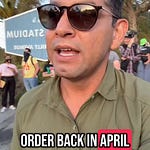By Nick Valencia
LOS ANGELES — For years, when we heard about Black and Latino unity in Los Angeles, it was often in the context of survival —navigating systems that were never designed for either of us. Sometimes we were allies. Other times we were rivals. But rarely, if ever, did it look like what I saw this week.
On the streets of downtown LA, I witnessed something that stopped me cold: images of Black and Brown people moving together — shoulder to shoulder, not out of necessity, but out of solidarity. Walking in rhythm toward something bigger. Something more hopeful.
I’ve lived this tension. I grew up in Northeast Los Angeles — Eagle Rock and Highland Park — where the phrase “the Brothas and the Ese’s” wasn’t always said with affection. There were real lines. Cultural divides. Racial slurs that didn’t need to be taught — they were inherited. Many of us still remember the years under Mayor Antonio Villaraigosa when violent crime was down in the city, except between the Black and Brown communities. And while things have shifted over the years, the pain of those divisions has never been far from the surface.
Tavis Hunter wears those scars. He goes by Big Boss. A 30-year-old from South Central — born and raised on Gage near Figueroa. He’s what his neighborhood calls a “city interventionist.” His job is to keep the peace before the police show up. He mediates street disputes, calms tensions at the park, and earns the kind of respect you can’t buy — only live.
When the immigration crackdown hit his South Central community, he didn’t just speak up. He stepped in.
“My gardener hadn’t been around in weeks,” he told me. “And when he finally did come, I told myself — if he’s gonna show up for me, the least I can do is make sure he gets home safe.”
This wasn’t all talk. Hunter was prepared to put himself between ICE and his friend.
“They just wasn’t gonna walk up and take him like that,” he said. “We was gonna put up some type of force… create some kind of distraction. Just so he could get back home.”
It wasn’t about politics. It wasn’t about optics. It was about loyalty.
“Anybody I consider my people — I’d go that extra mile for,” he said. “You got some people that say, ‘Why would you do that for them when they wouldn’t do that for us?’ But you can’t say that. You can’t paint a whole group of people off what one person didn’t do. That’s not real.”
Hunters tone is raw with empathy — and in the now viral social media clip, he has moral clarity.
“Who has the right to say where people can or can’t be?” he asked. “This whole world was made by God. Not man. These borders? That’s man-made. That’s just some dude in a room drawing a line.”
What we’re witnessing right now in LA isn’t just a protest or a flashpoint. It’s a rare moment of transformation — a resetting of old narratives. Too often, the only time we see Black and Latino unity in this city is in crisis — bonded by poverty, over-policing, or post-uprising trauma.
But what I saw last week wasn’t that. It wasn’t fear. It wasn’t chaos. It was intention.
That’s not to say the past doesn’t still echo. It does. There are people on both sides who still carry the scars of those years — who remember the street vendors who were attacked for clout, or the retaliatory threats that followed. But something is happening right now that deserves to be named. Honored. Studied.
Because in a city that’s long known division, we’re seeing something radical: cooperation.








Share this post